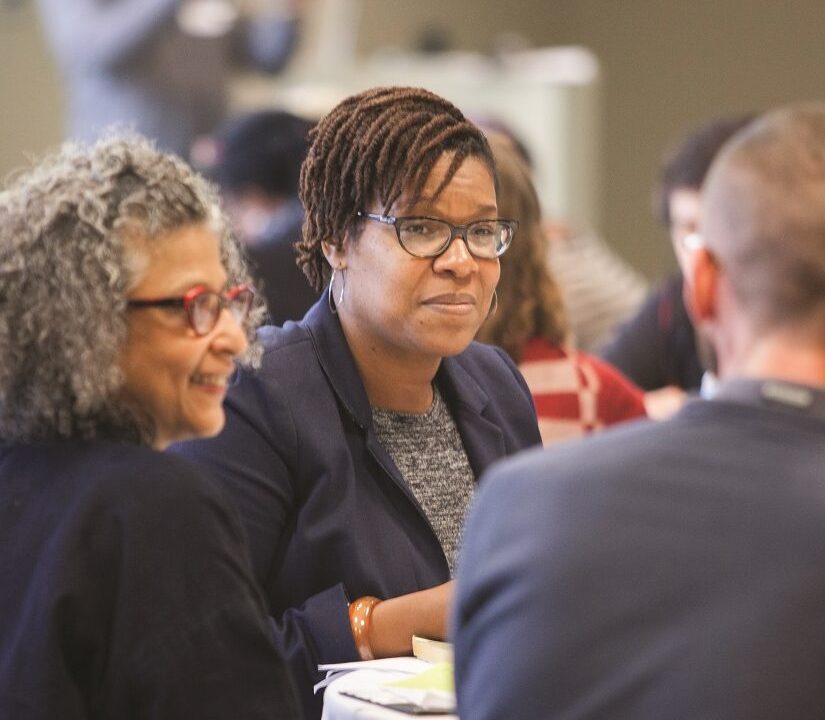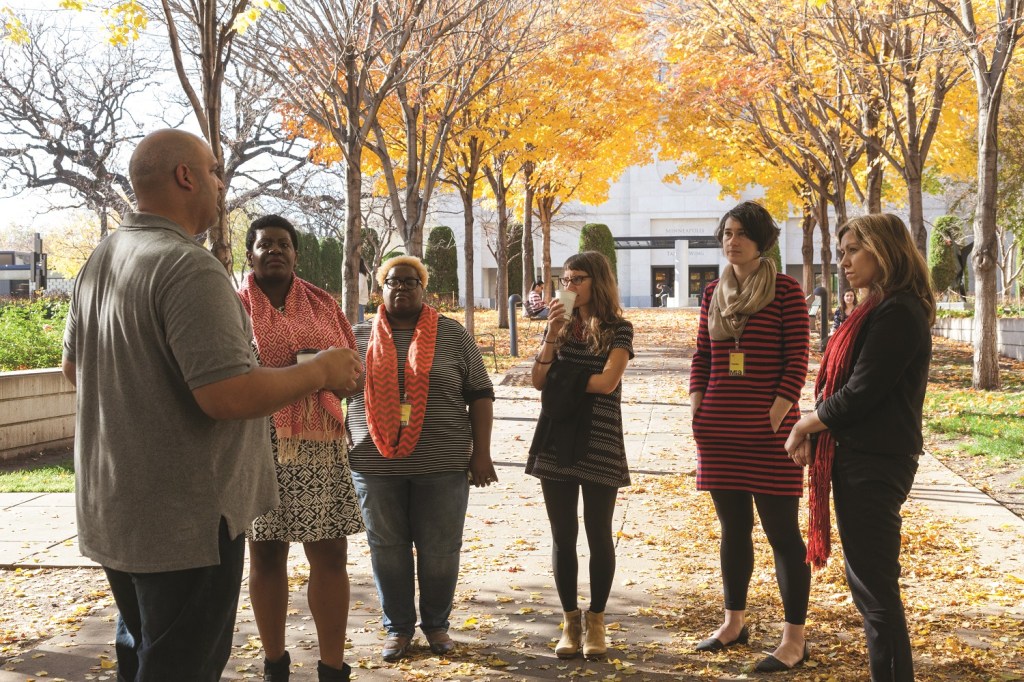
This article originally appeared in the January/February 2021 issue of Museum magazine, a benefit of AAM membership. In an effort to provide the broadest possible access to this critical topic, we are making these articles free and available to the public.
In December 2014, a group of museum thought leaders gathered to write a joint statement urging museums to speak out and respond to the police brutality and subsequent uprising in Ferguson, Missouri, and other cities across the country. They made the case that the country was at a pivotal moment for discussions about race—and museums, which are an important piece of the cultural and educational fabric of the nation, had a responsibility to be a part of that conversation.
Very few museums publicly responded to the statement. Some museums actively discouraged their staff from discussing the topic at all, assured that it was not their role to wade into issues of injustice in society. The urgency for a real, honest conversation about race, this watershed moment, began to recede. Many white-bodied museum staff were content, perhaps relieved, to set it aside.
Recognizing the need to continue to push for critical engagement on the topics of race and the history of racism in museums, Aleia Brown and Adrianne Russell began hosting online discussions using the hashtag #MuseumsRespondtoFerguson. These monthly Twitter chats offered museum staff a platform to express their frustration, to learn from one another, and, most importantly, to develop consensus that it is, indeed, museums’ role, as institutions created for the public benefit, to respond to societal injustices.
Mirroring, perhaps, the divide in our nation’s political landscape, the juxtaposition exposed by these conversations, between those calling for racial justice in museums and those content with the status quo, seemed like an immense chasm. However, there was also a group of people standing in the middle; they acknowledged the need for critical discourse about race but did not know where to begin.
This was the spark for MASS Action (Museum As Site for Social Action), the realization that museums need to, as adrienne maree brown detailed in Emergent Strategy, apply a “fractal conception” to this work, understanding that the characteristics of the smallest part of an organization will determine its larger function. In a museum application, if predominately white-bodied museum staff, unaccustomed to having to think or talk about race because of their own racial privilege, feel ill-equipped to talk about race on the individual level, how can museums do so at the institutional level? If museum staff who identify as Black, Indigenous, or people of color (BIPOC) are continually harmed by their institutions’ internal culture, policies, and practices, how can museums avoid harming BIPOC audiences at the institutional level?
Neutrality Is Complicity
MASS Action created a community of learning and practice to build a shared language and understanding, provide tools to support critical self-reflection and honest conversations, and shift museums toward more equitable, racially just practices. The collective efforts also provided a support network for BIPOC museum staff and white allies who are often the few people who take on the responsibility of centering racial equity when it might not be an institutional priority, and who are therefore at risk of being tokenized or harmed in these emergent discussions.
While MASS Action started with eight people on a fall day in 2015 in Minneapolis, it is now a movement, a network of hundreds of people, representing more than 100 museums across the country. In the intervening years, the conversation in the field has grown, too. There are hundreds of publications on the topic of diversity, equity, inclusion, and accessibility and millions of hours of thought-work by colleagues across the country. There have been conversations, convenings, conferences, protests, and interventions. Praxes have been established, toolkits created, and multimillion-dollar diversity grants awarded. “We have maps for days,” as Porchia Moore put it recently in a post on The Incluseum.
As a result of sustained conversations through #MuseumsRespondtoFerguson, MASS Action, Museums & Race, and #MuseumsAreNotNeutral, to name a few, more institutions are beginning to understand that their assumed neutrality is, in fact, complicity. In the wake of George Floyd’s murder, MASS Action began to catalogue and analyze museum responses and found that of the 1,088 AAM-accredited museums in the US, 572 posted a statement on their websites or social media expressing solidarity with Black Lives Matter.
In the years between #MuseumsRespond-toFerguson and the current moment, museum positioning has shifted enough that more institutions felt called to step forward in solidarity. But many visitors, staff, and former staff members pushed back on these statements as acts of performance with no substantive commitment or follow-through. And many questioned if these museums were still engaged in the anti-racism solidarity work that they signaled on social media.
There is a growing concern that, despite this field-wide interest and purported commitment to equity, little progress is being made. For all the efforts, museum staff of color continue to feel erased, marginalized, or otherwise harmed by their institutions. Recently, large numbers of former and current BIPOC museum staff mobilized to share personal accounts of racism in their institutions via a series of open letters and petitions. Several museum workers of color publicly resigned from their posts citing oppressive work environments, choosing personal financial strain over continued harm in their profession. Together, these testimonials paint a picture of a pervasive culture of white supremacy within our institutions.

Accountability to Change
The very model that museums were built upon supports the perpetuation of this white supremacy culture. The museum model prioritizes the acquisition and preservation of the object over the human: the people who create and inspire material culture, the workers, and the visitors. Upholding this object-centered approach manifests in practices across the museum—extracting free labor from interns, union busting, gross wage inequity, discriminatory hiring practices, and operating under scarcity models in service to capitalist markets—which indicate what museums value. During the pandemic, most museums are steadfastly clinging to the status quo, showing no signs of changing the model.
So the essential question remains: What needs to happen to effect substantive change in our field? Most museums have committed to racial equity seriously enough to impact structural change, so what will it take to make it happen? If museums treated racial justice with the same seriousness, budgetary support, care, and follow-through as an exhibition or a catalogue, would we still be having this same conversation in another five years?
The missing piece seems to be accountability. Museums, even small ones, operate within big, unwieldy systems of bureaucracy and, on an even larger scale, white supremacy. To shift direction, to push against the momentum of white supremacy created over hundreds of years, physics would tell us, will require consistent, intentional pressure. It is easy to get distracted, to pause, or to give up when results aren’t immediate or initial steps are unsuccessful. It is easy to sideline conversations when any conflict or disagreement arises, especially with white-bodied folks who hold positions of power. However, to hold ourselves and our institutions accountable for this work, we need to dig into this conversation and do so with transparency, vulnerability, and consistency. Here are some thoughts on how to do that.
Get uncomfortable. This work cannot be done without discomfort. One of the primary characteristics of white supremacy culture is fear of open conflict, so many of us tend to avoid it. Conflict can be generative and is absolutely necessary in the pursuit of racial justice. Productive conflict surfaces outdated notions of how we relate to one another in our work; it can expose the structural, uncomfortable truths about oppression and ultimately lead us to new, more equitable ways of working. In addition to having these courageous conversations, being accountable in this work requires vulnerability and humility. Racial justice is a human rights issue that requires humanity at the center.
Be transparent. In order to narrow the gap between institutional positioning and institutional action, museums need an open and ongoing self-examination mechanism through the lens of anti-racism. And museums need to make their learning visible to their publics. Without this, it is far too easy to stop and start this work on a timeline that benefits the museum, forgetting that racial injustice is urgent work all the time.
Think horizontally. This work is ongoing and generational. It will take time to undo systems of power that took hundreds of years to establish—and it will take everyone working on it. Your leadership models for this work need to look different. There is no equitable outcome without an equitable process.
Don’t reinvent the wheel. Racial justice in museums cannot happen by following a checklist. There is no one-size-fits-all roadmap; you must audit and individually address each one of your systems to impact the whole. But museums do not have to reinvent the wheel either. There are so many resources available, so many “maps” to choose from. (See the Resources at left for a select few.)
Remember who benefits. The only thing you cannot do is nothing. Not doing this internal work will continue to harm BIPOC staff and visitors. It will push out BIPOC staff talent, not to mention harm your institution’s relevancy and public reputation. And living in a racially unjust society hurts the white-bodied, too.
As we push against white supremacy culture and harmful legacies of colonization and oppression, we build liberation together for everyone. When we collectively set the bar for social justice in museums and other cultural institutions, everyone wins.
Put Your Action Where Your Words Are
Whether you are in a structural leadership position, a board member, a volunteer, or a casual/part-time worker, racial equity is part of everyone’s work. Below are some actions you can take today.
- Take MASS Action’s Readiness Assessment and compare results with your colleagues—where do you align, where do you differ, and why?
- Host a group reading of the MASS Action Toolkit.
- Identify your core values as an institution. If anti-racism isn’t one of them, discuss why or why not. If it is, make your commitments actionable and transparent to your public.
- Center racial equity. At what stage does racial equity come into play during internal decision-making processes? If it isn’t the central lens in how decisions are made, work with BIPOC staff, trustees, visitors, and other stakeholders to make it so. If you get stuck, ask yourselves, “What are we choosing over equity?” There is no equitable outcome without an equitable process.
- Center BIPOC staff. If your institution is focusing on diversity and equity without centering the care and retention of BIPOC staff, pause. Consider how you are authentically listening to staff of color’s needs.
- Apply a budget equity tool to assess how funds are being allocated in your institution. Create an actionable plan to address areas of funding inequity.
Resources
Kami Fletcher, “#MuseumsRespondtoFerguson: An Interview with Aleia Brown and Adrianne Russell,” Black Perspectives, September 29, 2016
MASS Action Toolkit & Readiness Assessment museumaction.org
Incluseum.com, including: nikhil trivedi, “Towards an Anti-Oppression Museum Manifesto,” November 9, 2015; and Porchia Moore, “Cartography: A Black Woman’s Response to Museums in the Time of Racial Uprising,” June 10, 2020
Death to Museums, A crowdsourced list of anti-racist action in museums [Google form] tinyurl.com/yaobzg98
Yesomi Umolu, “On the Limits of Care and Knowledge: 15 Points Museums Must Understand to Dismantle Structural Injustice,” ArtNet News, June 25, 2020
Adrianne Russell is a museum educator, writer, consultant, and co-founder of #MuseumsRespondtoFerguson. Anniessa Antar is the activation specialist at the Minneapolis Institute of Art. Elisabeth Callihan is head of multi-generational learning at Minneapolis Institute of Art and co-founder of MASS Action.Charts are from the CCTC Key Findings from Wave 1_final.pdf







